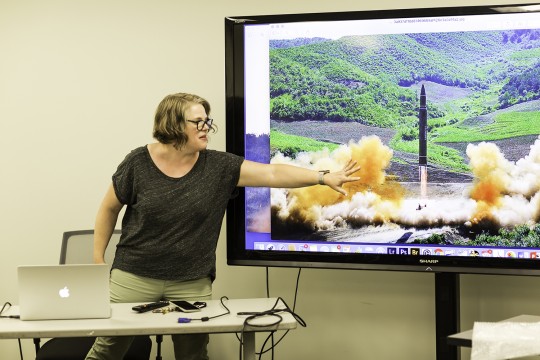News
Chester F. Carlson Center for Imaging Science
-
April 8, 2019
![13th century piece of parchment paper]()
Scientists use multispectral imaging to uncover lost text from manuscripts in Croatia
Croatia has a treasure trove of historically significant manuscripts, but after 800 years of fading ink and worms eating their parchment, much of the text has become impossible to read. Scientists from RIT are using multispectral imaging to make the writing legible once again and preserve the important information the manuscripts hold.
-
April 1, 2019
![Woman wearing glasses and floral print dress sits at table.]()
Cracking down on poachers with imaging
Elephant and rhino poachers in South Africa can run, but they can’t hide from drones. An imaging system created by a team led by Elizabeth Bondi ’16 automatically detects illegal hunters infiltrating national parks at night. Bondi’s deep learning system alerts the monitoring team who notifies park rangers or law enforcement of a potential threat to the animals under their protection.
-
March 6, 2019
![Three researcher watch hyperspectral camera on roof.]()
RIT researchers developing ways to use hyperspectral data for vehicle and pedestrian tracking
A classic scenario plays out in action films ranging from Baby Driver to The Italian Job: criminals evade aerial pursuit from the authorities by seamlessly blending in with other vehicles and their surroundings. The Air Force Office of Scientific Research (AFOSR) has RIT researchers utilizing hyperspectral video imaging systems that make sure it does not happen in real life.
-
February 7, 2019
![logo for RIT intersections: the RIT podcast.]()
Podcast: Space Travel and Toaster-sized Boats in the Sky
Intersections: The RIT Podcast, Ep. 8: Massive rocket ships aren’t the only way to explore space. Imaging science professor Grover A. Swartzlander Jr. and Amber Dubill, a mechanical engineering student, discuss the latest developments in space travel, including toaster-sized boats in the sky. Students are working solar sails, and developing RIT's first satellite.
-
November 20, 2018
![]()
Teaching computers to learn
While the technology has rapidly progressed, Christopher Kanan and his team are trying to make deep learning even more versatile. -
September 30, 2018
![Steve Wear and Sophia Maggelakis pose for a photo together, Wear holding the distinguished alumni award trophy.]()
2018 Distinguished Alumni: Meet Steve Wear
Meet Steve Wear ’91 MS (imaging science), the College of Science 2018 Distinguished Alumnus. -
July 16, 2018
![reflective-light solar sails attached to NASA’s Near-Earth Asteroid Scout.]()
Developing solar sailing technology for NASA
Grover Swartzlander, professor in RIT’s Chester F. Carlson Center for Imaging Science, is taking solar sailing to the next level with advanced photonic materials. This new class of materials could be used to steer photons and enable near-Earth, interplanetary and interstellar space travel. -
June 18, 2018
![student and professor talking.]()
Mapping artificial intelligence at RIT
Researchers in RIT’s Center for Human-Aware Intelligence believe their work could lead to breakthroughs in everything from health care to energy management to cybersecurity. -
April 23, 2018
-
March 29, 2018
![Two people working on a astronomical imaging system.]()
Using cinema technology for space missions
RIT scientist Zoran Ninkov is developing and testing an astronomical imager inspired by an Oscar-award winning cinema projection system. The RIT astronomical imaging system is competing with other technologies for deployment on future NASA space missions for surveying star and galaxy clusters.














